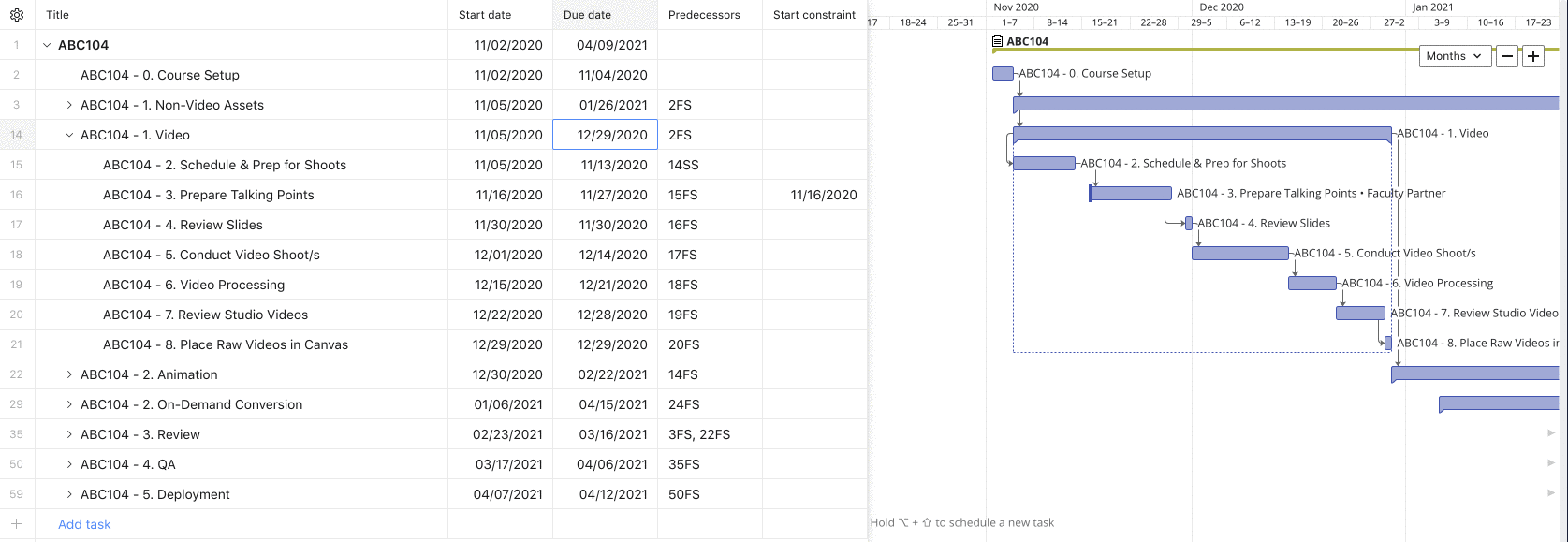Departmental Standards
Company-Wide
eCornell Styleguide & Branding
Cornell University Branding
Writing and Editing Style Guide
Faculty and Expert Naming Conventions in Courses
Cornell School and Unit Names
Tips for Campus Engagements
LSG
Legal Policies
CSG
Updating Wrike Due Dates
Photography Style Guide
eCornell Mini Visual Style Guide
The Pocket Guide to Multimedia Design Thinking (*as It Pertains to Your Job Here)
Creative Services (CSG) Handbook
Administrative
LSG Meeting Recordings and Notes
Sending Faculty Sign-Off Forms in Adobe Sign
Weekly Faculty Status Emails
Animation/Motion Design
Instructional Design
Required Course Elements
The Pocket Guide to Instructional Design Thinking at eCornell
Adding AER to Canvas
Grading
D&D Newsletter
LSG Newsletter (LSGN) - February 2024
LSG Newsletter (LSGN) - March 2022 Edition
LSG Newsletter (LSGN) - December 2023
LSG Newsletter (LSGN) - October 2021 Edition
LSG Newsletter (LSGN) - June 2022 Edition
D&D Newsletter November 2024
LSG Newsletter (LSGN) - August 2022 Edition
LSG Newsletter (LSGN) - June 2023
LSGN Newsletter April 2023
LSG Newsletter (LSGN) - February 2022 Edition
LSG Newsletter (LSGN) - October 2022 Edition
LSGN Newsletter February 2023
LSGN Newsletter March 2023
D&D Newsletter September 2024
LSG Newsletter (LSGN) - August 2023
LSG Newsletter (LSGN) - March 2024
LSG Newsletter (LSGN) - April 2022 Edition
D&D Newsletter - August 2024
LSGN Newsletter January 2023
LSG Newsletter (LSGN) - October 2023 article
LSGN Newsletter (LSGN) - April 2024
LSG Newsletter (LSGN) - November 2021 Edition
D&D Newsletter February 2025
LSG Newsletter (LSGN) - January 2022 Edition
LSGN Newsletter December 2022
D&D Newsletter April 2025
LSG Newsletter (LSGN) - July 2022 Edition
LSG Newsletter (LSGN) - September 2022 Edition
Course Development
Image Uploads for Inline Projects
How to Install the Firefox Canvas Utilities Extension
Revising a Course/ Creating a Redux Version/ Course Updates
Creating a Perma Link With Perma.cc
Course Content Deletion Utility — Removing All Course Content
Teleprompter Slide Template
Course Names
Requesting High Resolution Video Uploads
Technical Talking Points Template
Writing Discussions: Guidelines for IDs
Online Resources in Credit-Bearing Courses
Hiring Actors for an eCornell Project
Marketing
Operations
Tech
Master Course Template Differences (8675309s)
Non-CSG File Uploads
Mentored Learning Conversion Process and Resources
Doc-Based Master Course Template and Standards (8675309-DOC)
Pedagogical Guidelines for Implementing AI-Based Interactives: AER
Coding Master Course Template and Standards (8675309-CODE)
Practice Quiz Standards
Hero Image
Platform Training
Administrative Systems
ADP
Google Drive
Downloadables Process
Embed a Document from Google Drive
Adding Google Links to Canvas
File Naming and Storage Convention Standards
Google Drive for Desktop Instructions
Storing Documents in Multiple Locations
Wrike
Wrike System Fundamentals
Field Population
1.0 to 2.0 Wrike Project Conversion
Blocking Time Off in Work Schedule (Wrike)
Wrike Custom Field Glossary
Wrike "Custom Item Type" Definitions
How to Create a Private Dashboard in Wrike
Using Timesheets in Wrike
Importing Tasks into a Wrike Project
Wrike Project Delay Causes Definitions
Setting OOO Coverage for Roles in Wrike
How to Change a Project's Item Type in Wrike
Using Search in Wrike
How to Create a Custom Report in Wrike
@ Mentioning Roles in Wrike
Automate Rules
Using Filters in Wrike
Managing Exec Ed Programs in Wrike
External Collaborators
Wrike for External Collaborators: Getting Started
Wrike for External Collaborators: Views
Wrike for External Collaborators: Tasks in Detail
Wrike Updates
New Experience Update in Wrike
Wrike Course Development Template 2.0 - What's New
Wrike - Course Development Template 3.0 Release Notes
Wrike Process Training
Course Development & Delivery Platforms
Canvas
Development
Adding Custom Links to Course Navigation
Adding Comments to PDFs from Canvas Page Links
Setting Module Prerequisites and Requirements in Canvas
Canvas Page Functionality
Create a New Course Shell From 8675309
Using LaTeX in Canvas
Search in Canvas Using API Utilities - Tutorial
Reverting a Page to a Previous Version
Student Groups
Create Different Canvas Pages
Importing Specific Parts of a Canvas Course
Canvas HTML Allowlist/Whitelist
Understanding Canvas Customizations/Stylesheets
Operations
Discussion Page Standards
How to import a CU course containing NEW quizzes
Canvas LMS: NEW Quiz compatibility
Faculty Journal
Course Content Style Guide
Click-To-Reveal Accordions in Canvas
Course Maintenance Issue Resolution Process
Meet the Experts
Codio
Codio Operations
Managing Manually Graded “Reflect and Submit” Codio Exercises
Codio Structure and Grading for Facilitators
Premade Codio Docs for Ops & Facilitators
Codio Remote Feedback Tools for Facilitators
Developers
Development Processes
Creating a New Codio Course
Creating a New Codio Unit
Integrating a Codio Course into Canvas
Embedding a Codio Unit into Canvas
Setting Up the Class Fork
Jasmine Autograde Unit Testing
Setting Up the Class Fork (LTI 1.3)
R Studio - Exclusion List for R Code
Mocha/Selenium Autograding
Starter Packs in Codio
Configuring Partial Point Autograders in Codio
Launch a Jupyter Notebook from VM
AI Extensions
Program-Specific Developer Notes
Codio Functionality
Jupyter Notebooks
Jupyter Notebooks - nbgrader tweaks
Jupyter Notebooks Style Guide
Adding Extensions to Jupyter Notebooks
Setting up R with Jupyter Notebooks
Change Jupyter Notebook Auto Save Interval
How to Change CSS in Jupyter Notebook
RStudio in Codio
How To Centralize the .codio-menu File to One Location
Codio Fundamentals for LSG
Using the JupyterLab Starter Pack
Using Code Formatters
Using the RStudio Starter Pack
Conda Environments in Codio
Updating Codio Change Log
Codio Basics: Student Support
eC Facilitator Guide to Codio
Migrating to Updated Codio Courses
Qualtrics
Ally
Ally Institutional Report Training
Ally Features Overview Training
Using the Ally Report in a Course
Ally Vendor Documentation/Training Links
Adobe
Other Integrations
Pendo Overview
How to Add VitalSource eBooks in Canvas
Enabling Zoom/"Live Sessions" in a Course
Pendo Guide Creation
H5P
Modifying Subtitles in H5P Interactive Videos
Embedding H5P Content Into Canvas
Troubleshooting H5P Elements in Canvas
Inserting Kaltura Videos into H5P Interactive Videos
Adding Subtitles to H5P Interactive Videos
S3
BugHerd
Instructional Technologies & Tools Inventory
Canvas API Utilities
Getting started with the MOP Bot
eCornell Platform Architecture
HR & Training Systems
Product Development Processes
Accessibility
What Is Accessibility?
What Is Accessibility?
Accessibility Resources
Accessibility Considerations
Accessibility Support and Assistive Technology
Structural Accessibility
Accessibility Design and Development Best Practices
Accessible Images Using Alt Text and Long Descriptions
Accessible Excel Files
Accessibility and Semantic Headings
Accessible Hyperlinks
Accessible Tables
Creating Accessible Microsoft Files
Mathpix: Accessible STEM
Design and Development General Approach to Accessibility
Integrating Content Authored by a Third Party
Planning for Accessible Tools
Accessibility Considerations for Third Party Tools
Studio Accessibility
Designing for Accessible Canvas Courses
Accessibility: Ongoing Innovations
Course Development
Planning
Development
0. Design
1. Codio Units
1. Non-Video Assets
3. Glossary
4. Canvas Text
4. Tools
4. Tools - Wrike Task Definitions
3. Review And Revise Styled Assets
ID/A to Creative Team Handoff Steps
General Overview of Downloadables Process
Course Project: Draft and Final
Excel Tools: Draft and Final
eCornell LSG HTML Basics
1. Non-Video Assets - Wrike Task Definitions
2. Video
Multifeed Video
2. Video (Standard) - Wrike Task Definitions
Studio Tips
Tips for Remote Video Recording Sessions
Who to Tag for Video Tasks
3. Animation
3. Animation - Wrike Task Definitions
2. Artboard Collab Doc Prep
6b. Motion Design Review and Revise
Who to Tag for Animations Tasks
3. Artboard Collab Process Walkthrough
DRAFT - FrameIO Process Walkthrough
Motion Contractor Guide for IDAs / IDDs
Requesting / Using Stock Imagery (Getty Images and Shutterstock)
3. Ask the Experts
5. On-Demand Conversion
5. Review
5. Review - Wrike Task Definitions
1. Prep Course for Reviews
2. Conduct Student Experience Review
3. Implement Creative Director Edits
3. Implement IDD Edits
3. Implement Student Experience Review Edits
4. CSG - Revise Tools Export 1
5. Conduct Faculty Review
6. Implement Faculty Edits
7. Conduct Technical Review of Course (STEM-only)
Technical Student Experience (Tech SE) Review Process
2. Conduct IDD or Sr ID Review
6. Alpha
6. Alpha - Wrike Task Definitions
Alpha Review Process
Prepare a course for Alpha review
Schedule & Conduct Alpha Triage Meeting
7. QA
7. QA - Wrike Task Definitions
1. Prep Course for QA
2. Copy Edit Captions
2. Copy Edit Course & Files
4. Conduct Content QA of Course
4. Final Creative Review and Export
Adding Chat With Tech Support to Course Navigation
5. Implement QA Edits
Working With Video Captions That Contain Special Characters
Copy Edit Captions in SubPLY
Creating a Course Style and Settings Guide
Copy Editing Content in Frame.io
1. Complete Dev to QA Checklist
Copy Edit Captions in 3Play
Tag a Video for Transcription by 3Play
Course QA Checklists
8. Deployment
8. Deployment - Wrike Task Definitions
1. Finalize Master Version of Course
2. Create & Add Course Transcript (CT) to Course
Replace a Master -M With a Redux Version of the Course
3. Create -T (Training Course) and Associate With Master Blueprint
Canvas Blueprint Course Functionality
Project Management in Wrike
Managing Project Reporting in Wrike
Managing Task Needs/Schedule in Wrike
Adding Tasks
Comments and Communication
Statuses
Updating Task Start and Due Dates
Predecessors
Durations
Rollups
Calculating Project Schedule by Deadline in Wrike
Creating Course Project Plans in Wrike
Setting Custom Capacity for Resources
Customizing Effort in a New Project Plan
Marking Projects Complete in Wrike
How to Set Up Workload Charts to Track Effort in Wrike
For-Credit Considerations
1-Sheet Population
Post-Development
Program Facilitation & Operational Guidelines
Data Science
Facilitator Resources
Canvas Navigation
Adding Events to the Course Calendar
Navigating Canvas and the Dashboard
How Do I View Previous Courses I Have Taken or Facilitated?
Why Am I Receiving Duplicate Canvas Emails?
How Do I Edit My Canvas Profile?
Send Students a Direct Message on Canvas
Adding Notes to Canvas Gradebook
How Do I Send Students Nudges from the Gradebook?
Overview of 2024 Changes- Course Layout and Structure
How Can I Update My Canvas Notification Preferences?
Ursus Navigation
How Do I Access My Offer in Ursus?
How Do I Edit My Ursus Profile?
How Do I Request Time Off (Blackout Dates)?
How Can I Request to Learn More Courses?
Live Sessions
When Should I Schedule My Live Sessions For?
Changing Live Session Date and Time After Created with Facil Tool
Help! I Need to Reschedule a Live Session
Live Session Information page
Set up Live Sessions with the Facil Tool
Combining Live Sessions with Facil Tool
Course Set-Up
Course Set Up: Getting Ready for Live Sessions
Recording and Posting a Welcome Video
Course Set Up: When can I begin to edit my course?
Course Set Up: Reviewing Due Dates
Course Set Up: Reviewing Announcements
What Do I Need to Do to Make Sure My Course is Set Up Correctly?
How Do I Customize My Course Sections?
Course Announcements and Messages Templates
Facilitator Focus
Zoom and other Technical Support
Reporting Spam/Phishing
How Do I Set Up My Zoom Account?
Support Resources for Facilitators
Live Session/Zoom Trouble Shooting Guide & Technical Readiness
How to Upload Videos to Zoom On-Demand
Student Survey FAQs
How Do I Save and Refer Back to Zoom Recordings?
How Do I Find My Personal ID Meeting link in Zoom?
Benefits as an eCornell Employee
Do I Have Access to Microsoft Office as a Cornell Employee?
Taking Courses as a Student
Professional Development Benefit
Student Success
Help! My Students Can't View a Video Within My Course
Extensions and Retakes
Policies and Navigation Resources for Students
Symposium Access Extension- Fall 2025
Students enrolled through special groups: Corporate and VA
Unique Circumstances for Student Extensions and Retakes
Communicating with Students via Canvas
Can I Provide Students with a Letter of Recommendation?
Understanding and Addressing Instances of Plagiarism
Support Resources for Students
Understanding and Addressing Use of AI
Help! My Student is Having a Hard Time Uploading a Video
Unique Student Situations
I Have a Student Requesting Accommodations- How Should I Proceed?
Canvas Mobile App
Messaging Students via the Canvas Mobile App
Setting up and Navigating the Canvas Mobile app
Setting up Push Notifications on Canvas Mobile
Canvas App Features for eCornell courses
New Facilitator Onboarding and Quick References
Facilitator Onboarding at eCornell
Why Do I Have Multiple eCornell email and Canvas Accounts?
Quick reference: Systems and Accounts we use at eCornell
Quick reference guide: Key eCornell Personnel
How do I Log Onto Canvas and Access FACT101?
How Do I Add eCornell to My Email Signature?
Training Course Review & Facilitation Authorization
What to Expect During Live Shadowing Experience
Setting up Email Forwarding
Facilitator Expectations and Grading Help
Changes in Grading Scheme: Incomplete/Complete and 75% to 85%
New (Embedded/Inline Format) How do I grade Course Projects?
Navigating the Gradebook and Accessing the Speedgrader
Quick Reference: Sort assignments in the Speedgrader
How do I Grade Quizzes?
(Old format) How Do I Grade Course Projects and Add Annotations?
Rubrics for Effective Facilitation
Is There an Answer Key for my Course?
How to Monitor and Promote Student Progress
How Do I Grade Discussions?
Adding an Attempt to a Course Project
How Quickly Do I Need to Provide Grading to Students?
Payroll and the Monthly Scheduling Process
Codio References
Manually Graded “Reflect and Submit” Codio Exercises
Codio Quick Resources
Codio Reference: Embedded quiz questions (H5P)
Codio Reference: Checking for Completion Status
Codio Reference: Manually Graded Exercises
Codio Remote Feedback Tools
Codio Reference: Ungraded exercises
Codio Reference: Autograded Exercises
Archived
Table of Contents
Predecessors
The course template will come with pre-determined predecessors (aka "Dependencies") associated with each task. These are the standard relational effects between each task. For some courses, it might have been determined during the Planning stage that tasks will be started in a non-standard sequence. Adjusting the predecessors will reflect these changes in the structure of your project schedule.
The Benefits of Using Predecessors
The main utility of predecessors is to minimize the amount of manual updating that is needed to keep task's dates current and up to date. Predecessors achieve this by automatically updating tasks' start and due dates based off changes that are made to other tasks further up in the dependency chain. Here is a visual example of how they accomplish this:

Without using predecessors in the above example, the user responsible for keeping this project up to date would have instead had to manually update all of the dates of the tasks that followed the first task that had its dates changed. Or, if the tasks had neither dates nor predecessors applied to them, and a task was then assigned to another user, the project overseer would have then had to manually enter any start and/or due dates that were needed by the assignees for task completion clarification. This is exactly why learning how to intelligently use predecessors can save you a lot of project upkeep time.
Understanding Predecessor Fundamentals
Predecessors are a feature within Wrike that allow for the creation of date-based relationships between a project's tasks. They establish a formula that sets when a task will either start and/or finish. There are multiple types of predecessors that can be applied to individual tasks by setting specific values within either the Table or Gantt views within projects. Accessing them can be done by toggling the "Predecessor" field in either Gantt or Table view.

Predecessors can reduce the amount of manual updates that are necessary to keep task dates updated. Understanding how predecessors work will enable you to keep your project schedule in alignment with changes in the development plan that deviate from the default task sequence.
Predecessor values have two relationships with tasks. First, they interact with the "Selected" task. For the purpose of this article, the "Selected" task is the task on which the predecessor value is being placed. Second, they interact with one or more "Predecessor" tasks. A "Predecessor" task has the task row number which the predecessor value references. See below for a visual representation:

"Predecessors" vs. "Dependencies"
You may also hear the term “Dependencies” used to refer to predecessors. If you open a task’s card view, you will also see the “Dependencies” listed there. So, what is the difference between “Predecessors” and “Dependencies”?
The term “Dependencies” refers to both sides of the relationship between tasks - the predecessors and the successors. As you’ll see in the card view, a task may have both “Predecessor” dependencies and “Successor” dependencies.
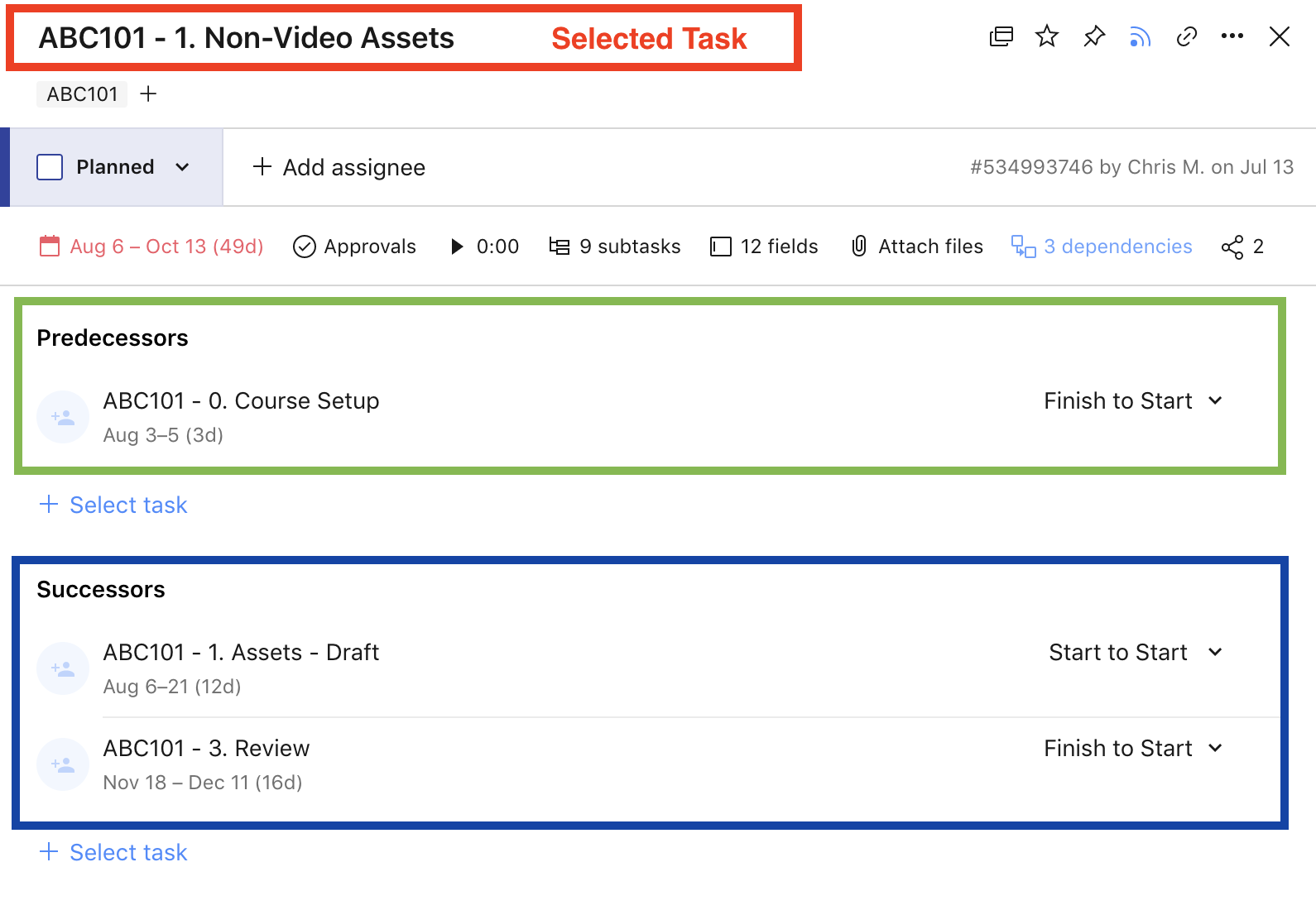
The Predecessors are tasks which have dates that the selected task’s dates depend on. The successors are tasks which have dates that depend on the selected task’s dates. So as described, the term “Predecessor” relates to one side of the dependency chain.
Why then in Wrike can you only add the “Predecessor” field in the gantt and table view? Why can you not also specify the “Successors” in those views? The answer is that it’s a simpler user experience. By specifying all of the predecessors in a project schedule, you have automatically also specified the successors. By only focusing on the predecessors, and going down the list, it’s easier than thinking about both ends of the dependency relationships for every task, one at a time.
Types of Predecessors
There are four types of predecessors within Wrike. Here are the four types with a brief description of each:
- Finish to Start (FS): Indicates that the selected task cannot start before the predecessor task has finished.
- Finish to Finish (FF): Indicates that the selected task cannot finish before the predecessor task has finished.
- Start to Finish (SF): Indicates that the selected task cannot finish before the predecessor task has started.
- Start to Start (SS): Indicates that the selected task cannot start before the predecessor task has started.
eCornell's projects primarily use the Finish to Start (FS) predecessors, and to a smaller extent Start to Start (SS) predecessors. Finish to Finish (FF) and Start to Finish (SF) are not currently used (except in rare specific instances).
Choosing Predecessor Use Per Project
We now provide project leads (mainly lead IDs) the option as to whether or not they would like to use predecessors on the second level of tasks within their projects. More specifically, when setting up Wrike projects for new programs, users can either use predecessors and dates on all tasks at all levels, or only on the top "bucket" levels, without any on the subtask level. For shorthand, we refer to these two different structures as either a "Task-Driven" schedule or a "Milestone-Driven" schedule. See below for a visual example of how these different structures look in the Gantt View.
Predecessors On All Tasks (Task-Driven Schedule):
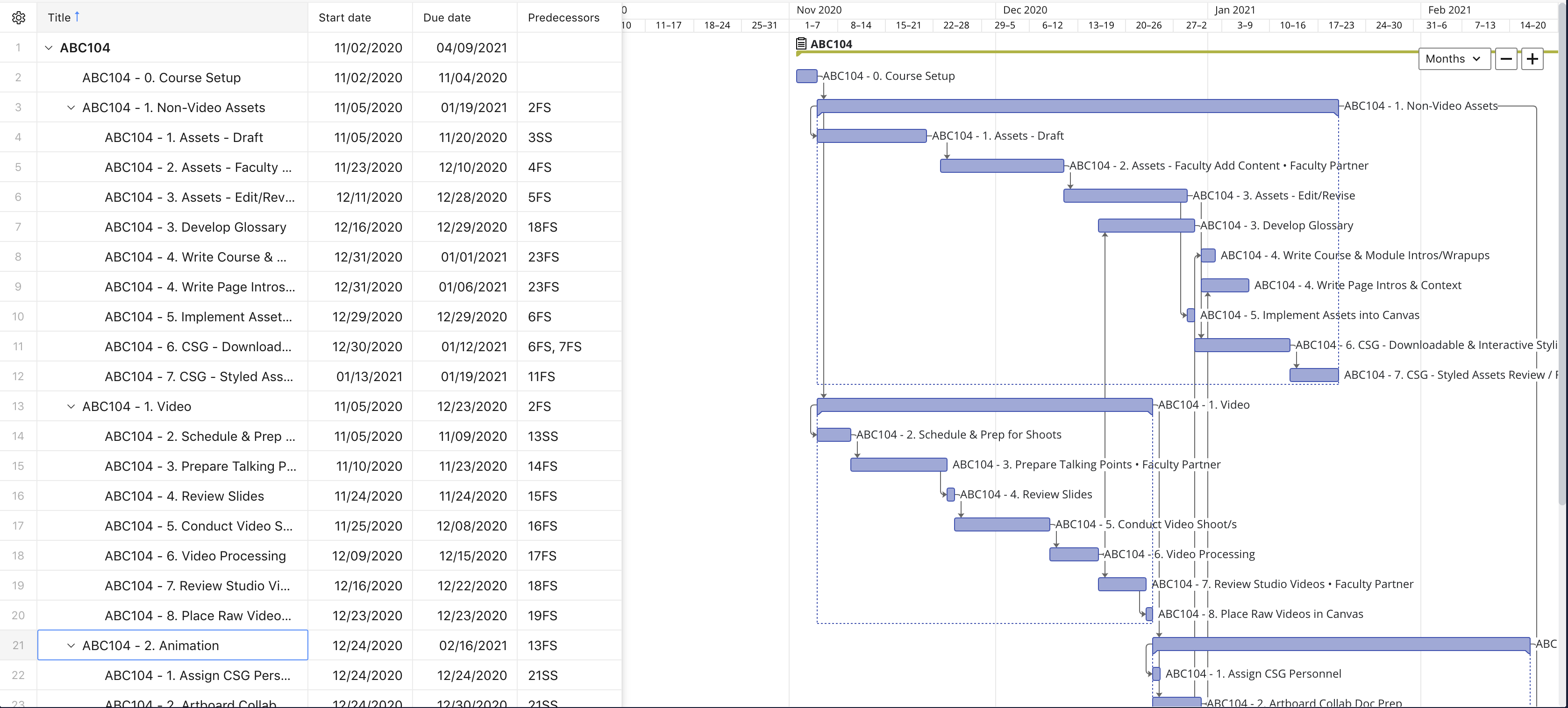
Predecessors Only On Bucket-Level Tasks (Milestone-Driven Schedule):
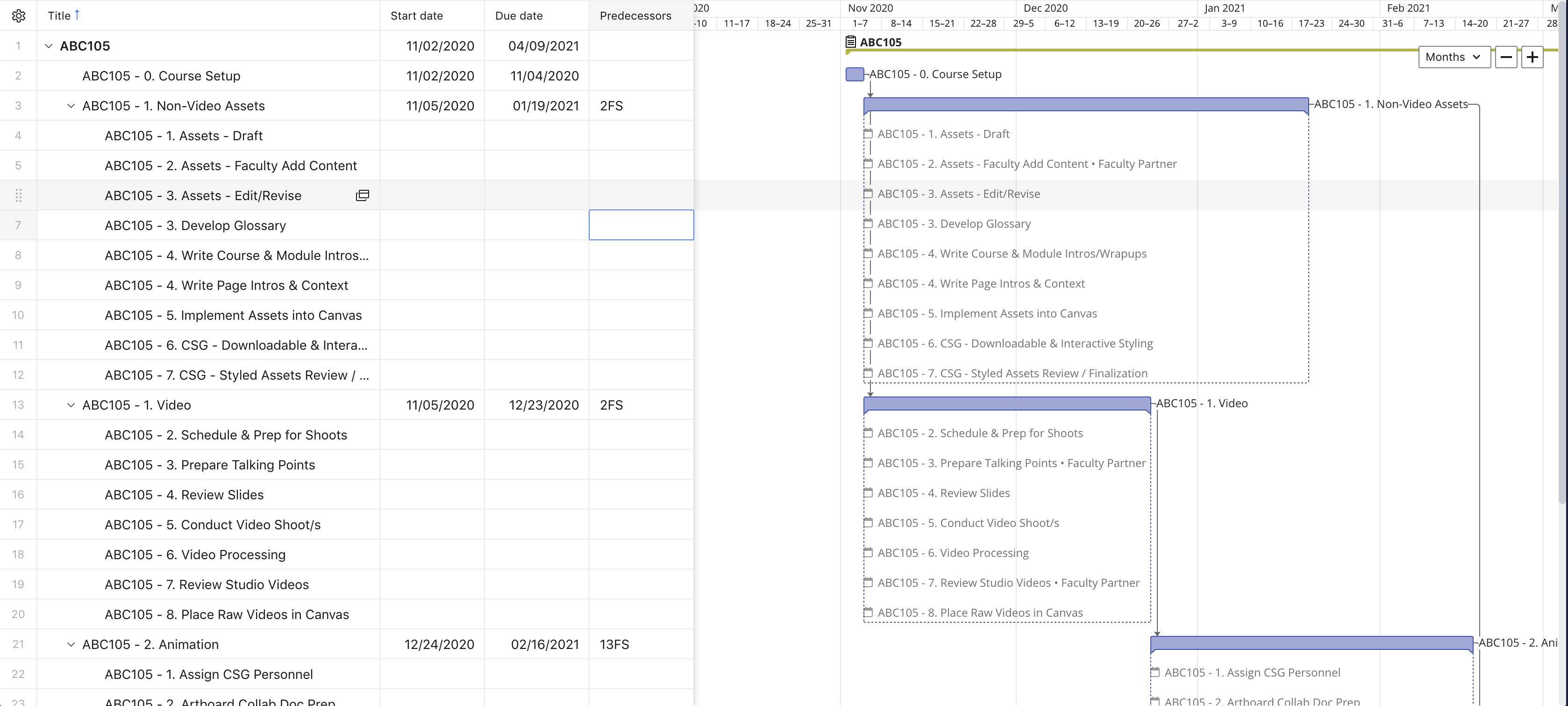
There are pros and cons to both approaches. We will break down the key pros and cons for each approach separately.
Predecessors On All Tasks (Task-Driven Schedule)
Pros:
- Reduced need for manual monitoring/updating of dates at the subtask level
- Tasks that are assigned out to internal service groups (Creative, Video, etc) will always have some form of a due date attached to them
- More informed context of how delays in one subtask will impact the overall schedule of the project
- More informed context of the assumed durations of tasks within the project
Cons:
- Increased amount of time needed/recommended to learn the fundamentals of how predecessors operate
- Higher potential for system related glitches/frustrations such as unpredicted task date changes and creation of Wrike "features" such as Start Constraints (more on this particular item below)
- Increased need for the use of the Item Rollup feature (covered in detail in another article within this category)
Predecessors Only On Bucket-Level Tasks (Milestone-Driven Schedule)
Pros:
- Reduced number of dates to manage
- Simplified user experience when keeping a course project's overall dates current
- Less of a need for users to understand predecessor fundamentals
- Potential to create a greater sense of ownership of the dates in a project for some users
Cons:
- Need to manually enter dates on tasks for cross-team and cross-user communication/clarification
- Lack of context in how updates to one task will affect the entire project's projected completion
- Increased level of responsibility and time for a project's overseer to maintain a project's dates
- Dates become increasingly abstract without a series of relationships to more specific deliverables
Adding Predecessors
Predecessors can be added to any unique tasks in your projects, after the project has been created from a template. Predecessors will not automatically be included on tasks that added outside of the templated tasks for eCornell projects. In order to add predecessors to these tasks, the aspects of predecessors described in this article should be considered.
First, a user will need to establish what "Predecessor" task is going to be affecting the start and completion of the "Selected" task (the unique task being added to the project). The user will then need to determine the task number of the predecessor task. Then, the user will need to assess if there are any other potential tasks that should be specified as a predecessor of the selected task, as multiple predecessor relationships can be applied to a single task.
Once these have been determined, the user will then need to determine the type of predecessor that reflects the relationship between the tasks. For simplicity's sake, it is recommended to always lean towards using the Finish to Start (FS) predecessor type.
Here is an example of all of these steps being carried out:
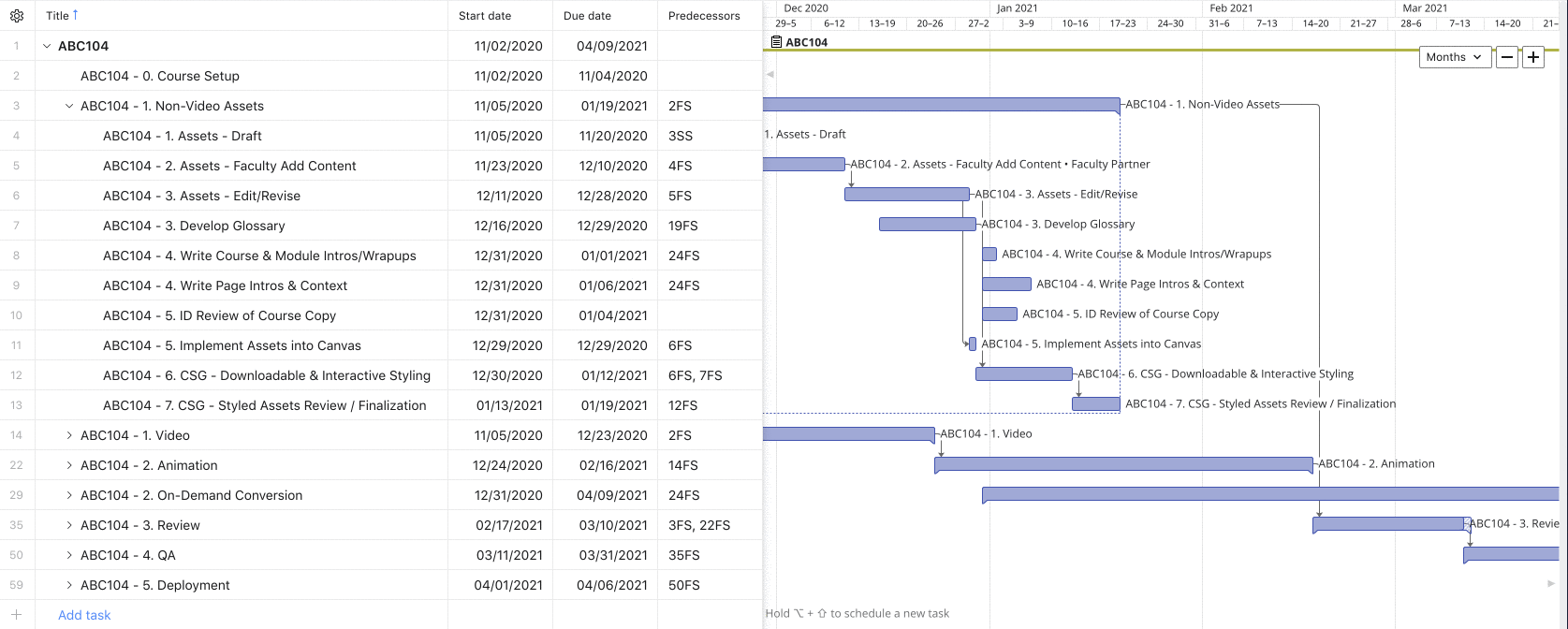
In the above example, the tasks "4. Write Course & Module Intros/Wrapups" and "4. Write Page Intros & Context" have been assigned to the project's IDA. For thoroughness, a new task called "5. ID Review of Course Copy" has been added. Since both of the existing tasks will need to be completed before the new task can begin, both tasks will be the predecessor tasks. We then establish that this new task which is the "selected task", would need a Finish to Start (FS) predecessor (the selected task cannot start until the predecessor tasks have finished). So, after finding the line numbers of the predecessor tasks, the predecessor values "8FS" and "9FS" are placed. You can then see, whenever either of the predecessor tasks are pushed out, the start date of the selected task is automatically pushed out by the system.
Overriding and Removing Predecessors
A user managing a project may reach a point where predecessors on certain tasks are creating more trouble than value. Some examples of when this can happen are:
- Task(s) dates need to be strictly specified for a determined timeframe because of a hard due date for task completion. If a task needs to be started or completed at very specific date, it might be necessary to remove predecessors from the task, so any changes to tasks further upstream do not move that task's established dates.
- Continued date malfunctions and frustrations managing a project's schedule. If a user is having continued frustrations and is "fighting" with their project's dates when trying to keep the project up to date, they might want to consider reverting to the option mentioned above in removing the dates/predecessors on all 2nd level tasks in the project, or specifically removing the dates/predecessors on a particularly bewildering task(s).
Removing the predecessor(s) of a task can be done by toggling on the predecessor field in the Gantt or Table view of a project, and simply remove/delete any present predecessor values.
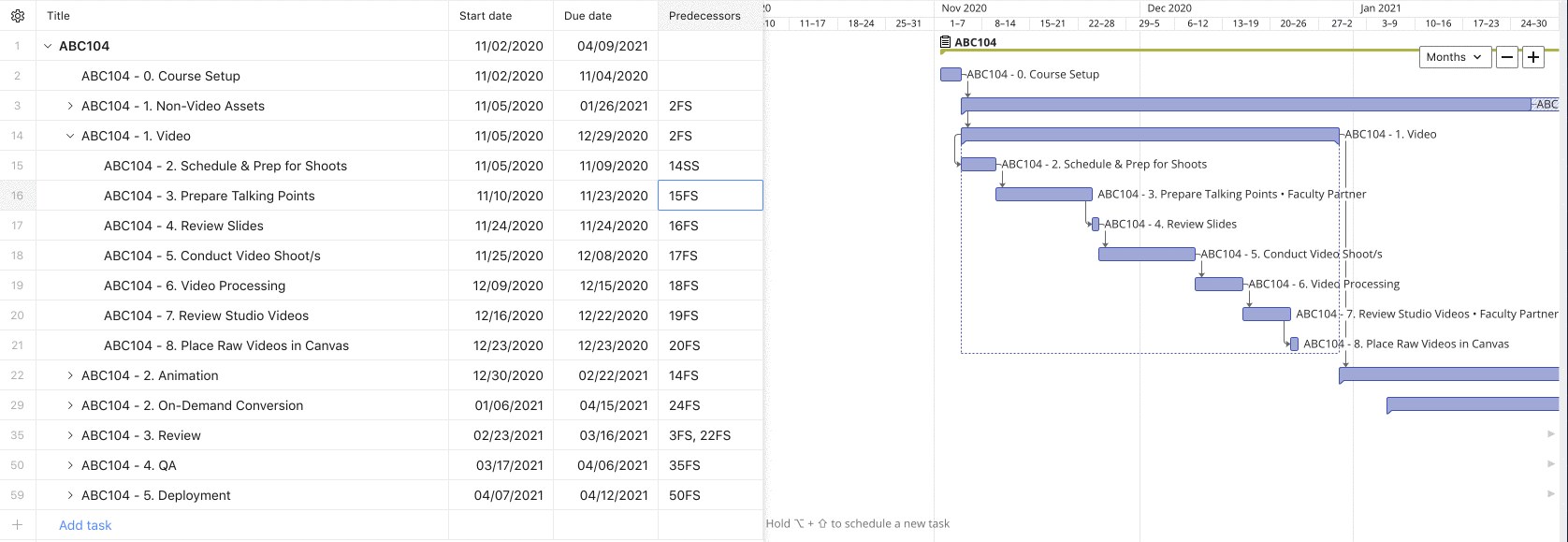
If a user wishes to remove the dates completely from a task, they can do so by simply deleting either the due date, or the duration of the task. Deleting the due date will remove the dates, and the predecessors from a task. Deleting the duration of task will remove the duration, predecessors, and dates from a task.
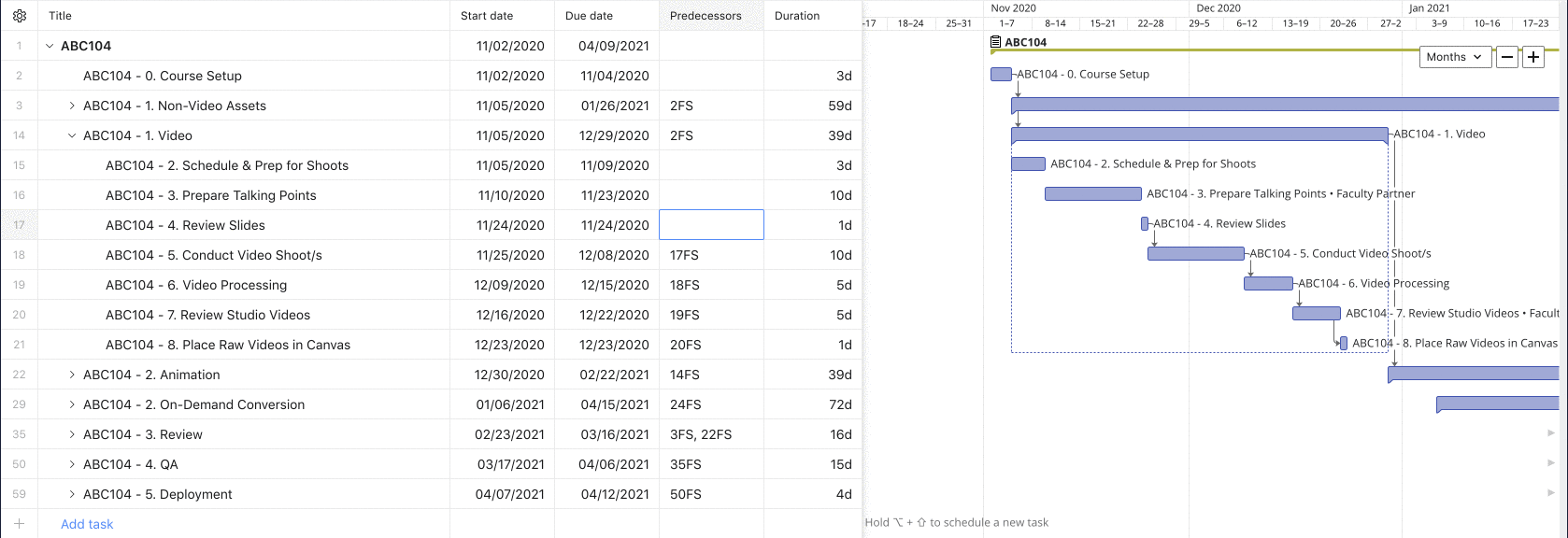
Advanced Topic: Start Constraints
One issue that occasionally occurs is the unintentional inclusion of system generated values called "Start Constraints". A Start Constraint will make it so that a task can no longer be scheduled before the date that has been set as the constraint. This affects the way the project's dependency chain functions. Start Constraints are at times generated when Finish to Start predecessors are placed on tasks within a project (it is still unclear at this time what conditions establish these start constraints being generated automatically). In terms of eCornell's use case, these start constraints are an issue, not a helpful feature, so it is prudent for users to remove them from tasks when they appear.
Recognizing when a start constraint has appeared can be done through examining the graphical Gantt chart of a project. When a task has a solid dark line present at the very beginning of its gantt block, that means there is a start constraint present on that task. Toggling on the start constraint field will show the user the exact date of the start constraint.
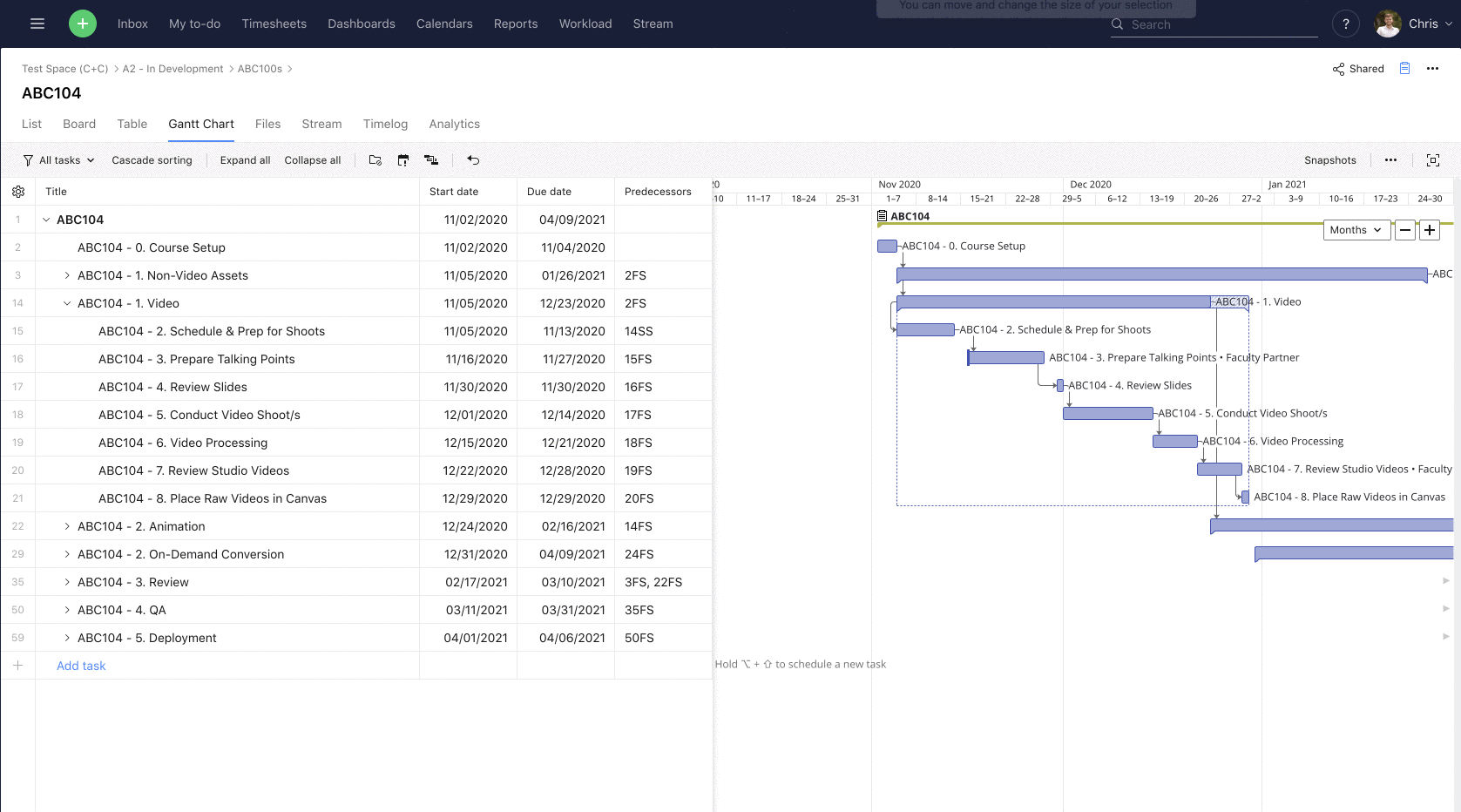
Removing a start constraint can be done by toggling on the Start Constraint field in the Gantt view of a project, and then removing/deleting that date. That will then allow the predecessors to freely adjust the task's start date once more.
